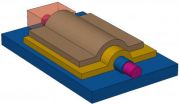(Press-News.org) A new, free software tool from the National Institute of Standards and Technology (NIST) could prove to be a breath of fresh air for architects and designers of ventilation systems for "green" commercial buildings.
With the Climate Suitability Tool,* building design teams can evaluate whether the local climate is suitable for cooling a prospective building with natural ventilation or requires a hybrid system that supplies supplemental cooling capacity. The tool is based on a model of the heat-related characteristics of a building configured to take full advantage of ambient climate conditions and natural air movement. It incorporates an algorithm—or problem-solving procedure—that crunches hourly weather data (downloaded from annual datasets for U.S. localities) and uses standardized criteria for rating the comfort of building occupants.
"We think this tool will be useful during the early stages of design, when decisions on the form of a building and its components are being made," explains NIST mechanical engineer Steven Emmerich. "It provides estimates of ventilation rates for preliminary design calculations. You can approximate how many air changes per hour will be necessary to offset heat gains due to the occupants, equipment and lighting so that comfortable conditions are maintained."
The effects of direct natural ventilation and a nighttime cooling procedure are assessed using a method devised by James Axley, Yale University professor of architecture and engineering. When the outdoor temperature is below an accepted threshold, direct ventilation through open windows and by other means can deliver the cooling to maintain the comfort zone. When the outdoor temperature exceeds the threshold during the day but drops below it after sunset, the cooler nightime air can dilute heat gained during the day and build a reserve of cooling potential for the day to come.
Results include an estimate of the total number and percentage of hours that direct ventilation would be effective over the total for the year; the percentage of hours for which ambient conditions would be too cold, hot, or humid for direct ventilation; the total number of days warranting nighttime cooling; and the estimated percentage of days for which nighttime cooling would be effective.
In a recently published article,** Emmerich, Axley, and NIST's Brian Polidoro describe the capabilities of the new sustainability analysis tool, and present results of analyses of different scenarios in four U.S. cities representing a wide range of climates: Kansas City, Los Angeles, Miami, and Phoenix. They also evaluate the impact of an adaptive thermal comfort standard for buildings, issued by the American Society for Heating, Refrigeration, and Air-Conditioning Engineers (ASHRAE). The ASHRAE standard (55-2010) includes an option for specifying a range of temperatures as opposed to setting fixed maximum outdoor temperature at which occupants will become increasingly uncomfortable.
Studies have found that occupants of naturally ventilated buildings tolerate a wider range of temperature than do people in air-conditioned structures. The researchers concluded that in cities with dry climates, such as Phoenix and Los Angeles, the adaptive thermal comfort option increases the effectiveness of natural cooling. Though not specified in the standard, humidity levels should be carefully considered when evaluating cooling and ventilation options, they recommended.
###
* The Climate Suitability Tool can be accessed at: www.bfrl.nist.gov/IAQanalysis/software/CSTdesc.htm
** S.J. Emmerich, B. Polidoro and H.W. Axley. Impact of adaptive thermal comfort on climatic suitability of natural ventilation in office buildings. Energy and Buildings (2010), doi:10.1016/j.enbuild.2011.04.016
New software tool helps evaluate natural cooling options for buildings
2011-05-26
ELSE PRESS RELEASES FROM THIS DATE:
NIST 'nanowire' measurements could improve computer memory
2011-05-26
A recent study* at the National Institute of Standards and Technology (NIST) may have revealed the optimal characteristics for a new type of computer memory now under development. The work, performed in collaboration with researchers from George Mason University (GMU), aims to optimize nanowire-based charge-trapping memory devices, potentially illuminating the path to creating portable computers and cell phones that can operate for days between charging sessions.
The nascent technology is based on silicon formed into tiny wires, approximately 20 nanometers in diameter. ...
Fish species discovered by LSU researcher makes 2011 top 10 list
2011-05-26
BATON ROUGE – The International Institute for Species Exploration at Arizona State University and a committee of taxonomists from around the world announced their picks for the top 10 new species described in 2010. Among their top picks is Halieutichthys intermedius, a pancake batfish recently discovered by Prosanta Chakrabarty, curator of fishes at LSU's Museum of Natural Science, and colleagues.
Halieutichthys intermedius, more commonly referred to as the Louisiana pancake batfish, gained some notoriety during the spring and summer of 2010, when the Deepwater Horizon ...
Public universities place greater focus on internal research services than public ones do
2011-05-26
Research expenditure has increased in Spain, as has the focus on research performance. However, the internal services that universities provide to support research, both in terms of infrastructure and staff, have not improved, according to a study published in the journal The Service Industries Journal, which also shows that public universities outperform private ones in this respect.
"The Ministry of Science and Innovation provides Spanish universities with access to databases. However, we have seen that in many cases there are no research support staff to explain how ...
New study provides global analysis of seagrass extinction risk
2011-05-26
A team of 21 researchers from 11 nations, including professor Robert "JJ" Orth of the Virginia Institute of Marine Science, has completed the first-ever study of the risk of extinction for individual seagrass species around the world.
The 4-year study, requested by the International Union for the Conservation of Nature (IUCN), shows that 10 of the 72 known seagrass species (14%) are at an elevated risk of extinction, while 3 species qualify as endangered.
The authors caution that loss of seagrass species and seagrass biodiversity will seriously impact marine ecosystems ...
Improved prognosis for esophageal cancer
2011-05-26
In recent years, the number of cases of adenocarcinoma of the esophagus (or gullet) has been on the rise. At the same time, however, new ways of treatment are improving the outlook for patients. In the current issue of Deutsches Ärzteblatt International (Dtsch Artzebl Int 2011; 108[18]: 313), Angelika Behrens and her working group report on innovations in diagnosis and treatment.
The main cause of this cancer is reflux of gastric acid from the stomach, with heartburn as the main symptom. Other risk factors are being male, being overweight, and having relatives ...
New bandwidth management techniques boost operating efficiency in multi-core chips
2011-05-26
Researchers from North Carolina State University have developed two new techniques to help maximize the performance of multi-core computer chips by allowing them to retrieve data more efficiently, which boosts chip performance by 10 to 40 percent.
To do this, the new techniques allow multi-core chips to deal with two things more efficiently: allocating bandwidth and "prefetching" data.
Multi-core chips are supposed to make our computers run faster. Each core on a chip is its own central processing unit, or computer brain. However, there are things that can slow these ...
Global warming may affect the capacity of trees to store carbon, MBL study finds
2011-05-26
MBL, WOODS HOLE, MASS.—One helpful action anyone can take in response to global warming is to plant trees and preserve forests. Trees and plants capture carbon dioxide during photosynthesis, thereby removing the most abundant greenhouse gas from the atmosphere and storing some of it in their woody tissue.
Yet global warming may affect the capacity of trees to store carbon by altering forest nitrogen cycling, concludes a study led by Jerry Melillo, Distinguished Scientist at the Marine Biological Laboratory (MBL) Ecosystems Center, and published this week in Proceedings ...
New Canadian blood pressure education program a powerful tool in fight to reduce stroke
2011-05-26
(Toronto, May 25, 2011): High blood pressure – the silent killer – is taking a hit from a new, ground-breaking treatment program from the Heart and Stroke Foundation of Ontario.
Last Sunday, in New York City, Dr. Sheldon Tobe, Chair of the Canadian Hypertension Education Program (CHEP) and a long-standing Heart and Stroke Foundation researcher, unveiled a new and powerful tool in the management of hypertension at the American Society of Hypertension (ASH) Scientific Meeting —The Heart&Stroke Hypertension Management Program.
"Diagnosing high blood pressure (hypertension) ...
2020 vision of vaccines for malaria, TB and HIV/AIDS
2011-05-26
SEATTLE, WA, May 25, 2011 – Collectively, malaria, TB & HIV/AIDS cause more than five million deaths per year – nearly the entire population of the state of Washington – and represent one of the world's major public health challenges as we move into the second decade of the 21st century. In the May 26, 2011, edition of the premier scientific journal Nature, Seattle BioMed Director Alan Aderem, Ph.D., along with Rino Rappuoli, Ph.D., Global Head of Vaccines Research for Novartis Vaccines & Diagnostics, discuss recent advances in vaccine development, along with new tools ...
Can we get there from here? Translating stem cell research into therapies
2011-05-26
A new article published by Cell Press in the May 26 issue of the journal Neuron provides comprehensive insight into the current status of neural stem cell research and the sometimes labyrinthine pathways leading to stem cell-based therapies. The perspective on translating neural stem cell research into clinical therapeutics is part of a special issue of Neuron devoted to neural stem cells and neurogenesis and is published in collaboration with the May issue of Cell Stem Cell, which also has a selection of reviews on this topic.
Neurological disease and injury are a major ...



